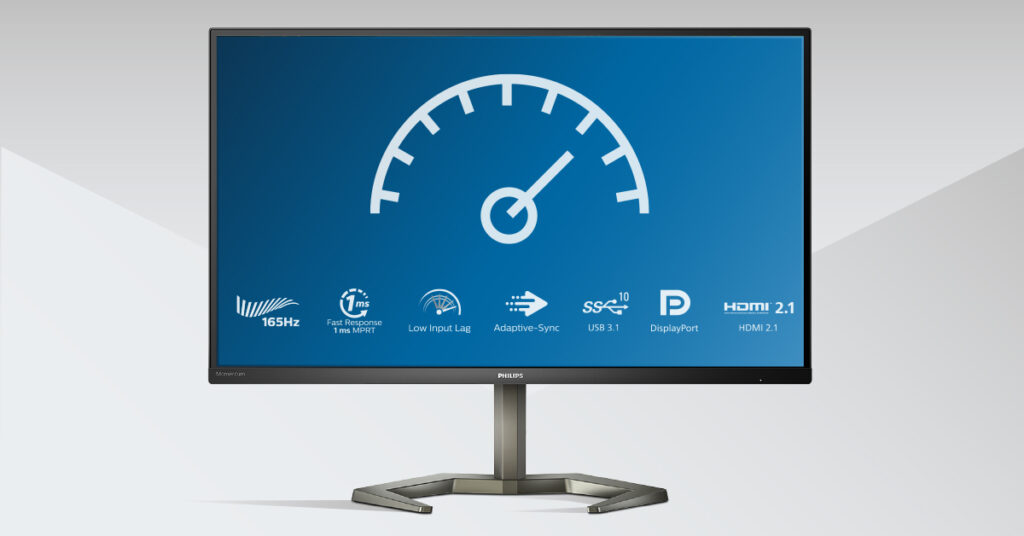Features that make your monitors run faster
Technology is led by never-ending strive for improvement, for assuring greater possibilities and for a better user experience. Speed is an important element when it comes to user experiences with monitors, and this can be affected by both monitors and PC. Luckily, there are some existing features that could already accelerate the actions of monitors and make the usage effortless.
Refresh rate, response times and input lag
Simply put, refresh rate is the rate at which the image is redrawn on the display. It is measured in Hz (Hertz) and the higher the refresh rate, the less exhausting it will be for your eyesight. However, the number of images and the fluidity of the game are directly related to the number of Frames Per Second (FPS) your computer will be able to deliver – which is an important information one might neglect. The latest Philips PC gaming monitor 24M1N3200ZA offers up to 165Hz to take gaming to the next level.
On the other hand, response time for monitors is the time it takes to shift from one color to another, and it can be measured in the time it takes to go from black to white, and back again to black (or, sometimes, gray-to-gray or GtG) expressed in milliseconds (ms). The fewer milliseconds response time takes, the better image and motion production. Response time is dependent on the hardware itself, and it has nothing to do with the frame rate. There are online tests that could help you understand more of the refresh rate of your hardware, and the tests can also show what is called moving picture response time (MPRT) of the monitor. MPRT is indeed different from GtG: while GtG measures how long it takes for a pixel to change color, MPRT represents how long a pixel is visible for, and a fully refreshed pixel can stay visible until the next refresh cycle, which has nothing to do with a color change. Being two different numbers and calculations, GtG and MPRT may result in different times but the closer they get to 1ms, the better.
A low MPRT eliminates smearing and motion blur, while a high refresh rate assures no screen tearing, delivering shaper, precise and smooth visuals to enhance user experience. However, a lower refresh rate and/or longer response time can cause ghosting. Ghosting on monitor is when you can identify an image that was previously displayed leaving a trail in the currently shown image with some kind of blurriness effect, causing smearing to the currently shown image. Knowing how annoying and uncomfortable this effect is on users, Philips Gaming monitors (the beforementioned 24M1N3200ZA is a perfect example) ensure a fast response time for exciting gameplay sessions.
Input lag is the amount of time that passes between sending a signal input and the time it takes for the sent input to appear on the screen. Low input lag is crucial in gaming, (a high level of input lag of the monitor in use will negatively impact the overall gaming experience) since it reduces the time delay between entering a command from your devices to monitor, particularly important to whom plays fast-paced, competitive games.
The power of syncing your monitor and your laptop
Another feature you should look for is sync technology. You might have read names like AdaptiveSync, AMD Freesync and G-Sync, but what does all this mean? Sync technology is the dynamic adjusting of a monitor’s vertical refresh rate to the frame rate of the graphics card (GPU) of the PC in use. Although specific for the gaming industry, any user can appreciate a good sync technology, which adapts the refresh rate of the monitor to match with the framerate of the video content on it, enable the device to function without any tearing and stuttering. For gamers, this alignment is crucial, as in videogames, different scenes demand varying levels of framerates. For example, the latest Philips 24M1N3200ZA, a brand new Full-HD PC gaming monitor, features Adaptive Sync for intense gameplays.
AMD Freesync utilizes this technology, leaving the framerate range in the hands of the manufacturers. NVIDIA G-Sync uses the same principle, relying on proprietary hardware that must be built into the display.
Connectivity: the power of cables
Each port and each cable have different functionalities, and the most famous port is probably USB. Over the years it progressed from USB 1.0 (sometimes called Low-Speed) that supports a transmission rate of only 1.5 Mbps, up to the USB 3.1 that transmit 10Gbps. A new standard in connectivity that can ensure a fast, complete, and easy connectivity is USB-C (whose usual protocol is either USB 3.1 or USB 3.2, up to 10Gbps). Many Philips Monitors feature USB-C connectivity, to meet the needs of professionals and corporate environments. An example is the Philips 279P1 which offers 90W power delivery and a simple laptop docking solution to view UHD images, recharge a laptop and stay connected to Ethernet with a single USB-C cable.
DisplayPort (DP) is a digital display interface used to transmit video and audio signals to a display unit, such as a monitor. This port is highly efficient and capable of transmitting up to 100 watts (which is a lot!) over a single cable.
HDMI is another pretty common cable, starting from the very first HDMI in 2002 that could transmit up to 4.95 Gbits/s, we have now welcomed the latest HDMI 2.1, which supports the 48Gbps bandwidth. HDMI 2.1 can transmit high resolutions and faster refresh rates including 8K 60Hz and 4K 120Hz for immersive viewing and smooth fast-action details. The new Philips Monitor Momentum Designed for Xbox series feature this innovation in connectivity for the most optimized console gaming possible.
Is your set-up up to date? If not – better take a loot at all the features mentioned above for your monitors and see if it reaches your expectation.

